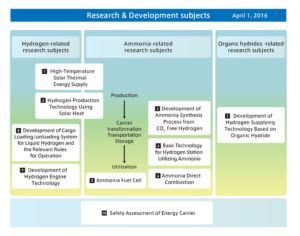Green Ammonia Consortium: Bright Prospects in Japan for Ammonia as an Energy Carrier
By Stephen H. Crolius on October 05, 2017
Ammonia Energy Anniversary Issue: a “top five” development in economic implementation
In the last 12 months …
In July 2017, 19 companies and three research institutions came together to form the Green Ammonia Consortium. Before this development, it was unclear whether ammonia would find a significant role in Japan’s hydrogen economy. In the wake of this announcement, however, ammonia seems to have claimed the leading position in the race among potential energy carriers.
Passing the baton: SIP “Energy Carriers” to Green Ammonia Consortium
Japan’s Cross-Ministerial Strategic Innovation Promotion Program (SIP) – the host of the Energy Carriers initiative – will wrap up operations at the end of 2018. It will be up to the proponents of each of the SIP’s three energy carrier options to take the technologies forward.

During the last year, proponents of both the other energy carriers, liquid hydrogen and liquid organic hydrides, announced that they will carry out capital-intensive pilot programs. A team consisting of Chiyoda, Mitsubishi and Mitsui will transport hydrogen produced at an oil refinery in Brunei via the use of methyl cyclohexane (MCH), one of the liquid organic hydrides. A team consisting of Kawasaki Heavy Industries (KWI), Iwatani, J Power, and Shell will transport hydrogen extracted from Australia lignite on specially built liquid hydrogen ocean tankers. The investment in the KWI project is projected at “tens of billions of yen” (hundreds of millions of dollars). No figure is given for the MCH project, but it does involve construction of specialized facilities and the movement of up to 3,500 tonnes of MCH.
The Green Ammonia Consortium consists of three national research institutes and 19 corporate members, all industrial heavyweights with obvious reasons to be interested in development of ammonia energy. Three of them are engineering-procurement-construction (EPC) firms, five are energy utilities, and the rest are manufacturers of machinery, chemicals, or vehicles.
While the Green Ammonia Consortium is not calling (yet) for the commitment of capital, the sheer number of participants and their caliber is testament to bright prospects for ammonia energy.
Ammonia Energy reporting on these topics:
- September 2017: Kawasaki Moving Ahead with LH2 Tanker Project
- August 2017: Major Development for Ammonia Energy in Japan: Green Ammonia Consortium
- August 2017: Japan-Brunei MCH Energy Carrier Demonstration
A year in review
To mark the first anniversary of Ammonia Energy, we reviewed the most important developments from the last 12 months. This “top ten” list spans two areas: five are technology advances that will arguably produce the most important opportunities for ammonia energy, and five are economic implementation steps that are arguably the most significant moves toward real-world deployment.
Technology advancement:
- The Dawn of Bio-Ammonia
- Advances in Ammonia-Fired Gas Turbines Open Up Major Use Case
- Overcoming the Selectivity Challenge in Electrochemical Ammonia Synthesis
- Progress toward Ammonia-to-Hydrogen Conversion at H2 Fueling Stations
- Development of Direct Ammonia Fuel Cells
Economic implementation:
- Yara’s Solar Ammonia Plant is a Key Step toward Global Trade in Renewable Energy
- Power-to-Ammonia: the Economic Viability of Ammonia Energy
- Green Ammonia Consortium: Bright Prospects in Japan for Ammonia as an Energy Carrier
- The Maritime Industry Begins Assessment of Ammonia as a Fuel
- Ammonia Energy Gains Recognition from U.S. Department of Energy